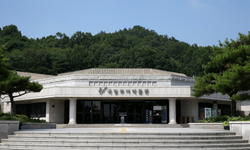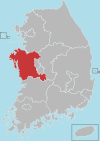Buyeo County
Buyeo
부여군 | |
|---|---|
| Korean transcription(s) | |
| • Hangul | 부여군 |
| • Hanja | 扶餘郡 |
| • Revised Romanization | Buyeo-gun |
| • McCune-Reischauer | Puyŏ-gun |
 Buyeo National Museum | |
 Location in South Korea | |
| Country | |
| Region | Hoseo |
| Administrative divisions | 1 eup, 15 myeon |
| Government | |
| • Mayor | Park Jeong-hyeon(박정현) |
| Area | |
| • Total | 624.65 km2 (241.18 sq mi) |
| Population (September 2024[1]) | |
| • Total | 59,823 |
| • Density | 152.4/km2 (395/sq mi) |
| • Dialect | Chungcheong |
Buyeo County (Buyeo-gun) is a county in South Chungcheong Province, South Korea. Buyeo-eup, the county's capital, was the site of the capital of Baekje from 538-660 AD, during which it was called Sabi Fortress.
Famous people associated with Buyeo County in more recent times include noted stem-cell researcher Hwang Woo-suk.
Geography
[edit]
Buyeo is located at the southern area of Chungcheongnam-do, the heart of the Korean peninsula.
During the Three Kingdoms Era, the capital of Baekje was moved to present-day Buyeo-eup (then called Sabi) on account of crowding in the former capital, which was near present-day Seoul. A fortress called Garimseong was constructed for defending the new capital.[2] Buyeo County has numerous historical sites from this era, such as the mountain fortresses (sanseong) at Seongheung, Buso, and Cheong, the tumuli at Neungsan-ri, and the temple site at Gunsu-ri, all designated Historic Sites of South Korea.
Climate
[edit]| Climate data for Buyeo (1991–2020 normals, extremes 1972–present) | |||||||||||||
|---|---|---|---|---|---|---|---|---|---|---|---|---|---|
| Month | Jan | Feb | Mar | Apr | May | Jun | Jul | Aug | Sep | Oct | Nov | Dec | Year |
| Record high °C (°F) | 17.0 (62.6) |
20.6 (69.1) |
25.3 (77.5) |
30.7 (87.3) |
33.3 (91.9) |
34.7 (94.5) |
37.7 (99.9) |
39.3 (102.7) |
34.1 (93.4) |
30.5 (86.9) |
25.9 (78.6) |
18.2 (64.8) |
39.3 (102.7) |
| Mean daily maximum °C (°F) | 4.4 (39.9) |
7.2 (45.0) |
12.7 (54.9) |
19.3 (66.7) |
24.5 (76.1) |
28.0 (82.4) |
29.8 (85.6) |
30.8 (87.4) |
26.9 (80.4) |
21.4 (70.5) |
13.8 (56.8) |
6.5 (43.7) |
18.8 (65.8) |
| Daily mean °C (°F) | −1.5 (29.3) |
0.7 (33.3) |
5.7 (42.3) |
11.8 (53.2) |
17.6 (63.7) |
22.1 (71.8) |
25.3 (77.5) |
25.7 (78.3) |
20.7 (69.3) |
13.8 (56.8) |
6.9 (44.4) |
0.4 (32.7) |
12.4 (54.3) |
| Mean daily minimum °C (°F) | −6.6 (20.1) |
−4.9 (23.2) |
−0.6 (30.9) |
4.9 (40.8) |
11.4 (52.5) |
17.2 (63.0) |
21.8 (71.2) |
21.9 (71.4) |
15.9 (60.6) |
7.7 (45.9) |
1.4 (34.5) |
−4.5 (23.9) |
7.1 (44.8) |
| Record low °C (°F) | −22.1 (−7.8) |
−16.6 (2.1) |
−12.5 (9.5) |
−5.5 (22.1) |
0.4 (32.7) |
6.8 (44.2) |
13.0 (55.4) |
11.2 (52.2) |
3.2 (37.8) |
−3.6 (25.5) |
−11.2 (11.8) |
−17.6 (0.3) |
−22.1 (−7.8) |
| Average precipitation mm (inches) | 24.9 (0.98) |
37.6 (1.48) |
50.9 (2.00) |
85.3 (3.36) |
97.5 (3.84) |
157.1 (6.19) |
295.7 (11.64) |
284.8 (11.21) |
146.0 (5.75) |
63.6 (2.50) |
51.8 (2.04) |
31.4 (1.24) |
1,326.6 (52.23) |
| Average precipitation days (≥ 0.1 mm) | 6.9 | 5.8 | 7.6 | 7.9 | 7.9 | 9.3 | 14.7 | 13.5 | 8.7 | 5.9 | 8.4 | 8.9 | 105.5 |
| Average snowy days | 7.8 | 4.9 | 1.8 | 0.1 | 0.0 | 0.0 | 0.0 | 0.0 | 0.0 | 0.1 | 2.2 | 6.2 | 22.8 |
| Average relative humidity (%) | 70.9 | 65.6 | 64.1 | 63.0 | 66.9 | 72.1 | 79.8 | 78.5 | 75.8 | 74.0 | 73.1 | 73.2 | 71.4 |
| Mean monthly sunshine hours | 164.4 | 173.6 | 209.6 | 222.5 | 236.5 | 199.3 | 157.7 | 184.5 | 187.2 | 198.8 | 155.6 | 153.3 | 2,243 |
| Percent possible sunshine | 57.8 | 61.3 | 60.4 | 62.3 | 58.7 | 52.4 | 43.9 | 52.7 | 57.1 | 63.1 | 55.2 | 55.6 | 56.6 |
| Source: Korea Meteorological Administration (snow and percent sunshine 1981–2010)[3][4][5] | |||||||||||||
Commerce
[edit]It wasn't until the early 2000s that Lotteria moved into the area, but in recent years it has become home to a variety of franchises.
As a traditional city, many coffee shops are built in the style of hanoks or have a Hanok concept.
On 8 September 2013, a new Lotte Outlet Buyeo branch was opened in Gyuram-myeon.
Baekje Cultural Festival
[edit]Buyeo County held its first Baekje cultural festival in 1955 celebrating the history of ancient Baekje and the culture that blossomed in the Buyeo area, sponsored by the residents of Buyeo County themselves. The province began
From 1965, the province officially announced to take place Baekje cultural memorial.[6]
The festival showcases traditional costumes and marching from the Baekje era, focusing on the works of the six kings of the Sabi era and the story of the loyalty of three subjects. This festival was ranked among the best in the country in 2007.[7]
Sister cities
[edit]See also
[edit]- List of Baekje-related topics
- Geography of South Korea
- Chungcheong
- Five storied stone pagoda of Jeongnimsa Temple site:located in Buyeo
References
[edit]- ^ "Population statistics". Korea Ministry of the Interior and Safety. 2024.
- ^ http://www.seoul.co.kr/news/newsView.php?id=20071115023006 [서동철 전문기자의 비뚜로 보는 문화재] (44) 부여 성흥산 대조사 석불입상 Retrieved on 2008-01-23
- ^ "Climatological Normals of Korea (1991 ~ 2020)" (PDF) (in Korean). Korea Meteorological Administration. Archived from the original (PDF) on 29 January 2022. Retrieved 4 April 2022.
- ^ 순위값 - 구역별조회 (in Korean). Korea Meteorological Administration. Retrieved 4 April 2022.
- ^ "Climatological Normals of Korea" (PDF). Korea Meteorological Administration. 2011. Archived from the original (PDF) on 7 December 2016. Retrieved 8 December 2016.
- ^ "백제문화재단".
- ^ 백제문화제 국가지정 축제 선정 [Baekje Festival nominated national festival]; Daejeon Ilbo 2007-12-28 Retrieved 2008-01-26



